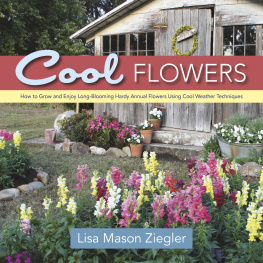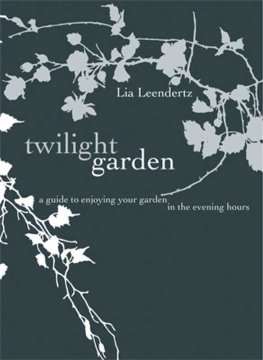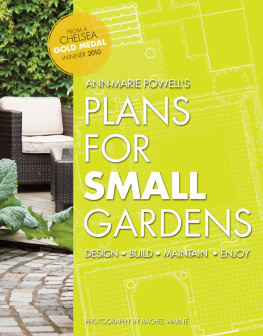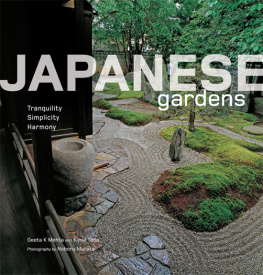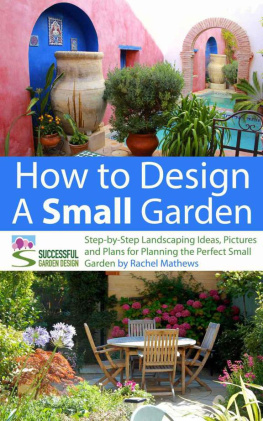Planning & Planting a Moon Garden
Marcella Shaffer
CONTENTS

Introduction
If youre like most of us, you work during the day. If youre also a gardener, that means you miss viewing and enjoying your garden during its prime time: the daylight hours. There is a way, however, to enjoy the full effect of your labor without quitting your job: Plant a night-blooming garden, otherwise known as a moon garden. Moon gardens are designed expressly for evening and nighttime enjoyment.
Although a moon garden is attractive at any time of day, at dusk it takes on a whole new look and feel, casting an almost magical spell. Alluring fragrances intermingle, enticing you to visit and discover their source. Comfortable seating invites relaxation, urging you to sit and admire the pale colors of the flowers and foliage as reflecting light from the setting sun and the rising moon gives the garden an almost mystical glow. Is it any wonder that Victorian green thumbs, who are generally credited with developing moon gardens, referred to them as dream gardens?
A night-blooming fragrant garden offers a peaceful and tranquil spot to rest and relax. It can be elaborate or simple, large or small. Even an out-of-the-way corner beside a garage or shed or a small section of lawn can be transformed into a moon garden. If you have limited gardening space, never fear: Many night-blooming plants grow well in containers, and your patio or deck can become a spectacular moon gardenyour own private haven from the world.
A Garden of Unearthly Delights
The most important aspects of a moon garden are the joy and relaxation you derive from it. However, a garden can provide only the setting; the rest is up to you. Forget about the days struggles and problems; let your mind unwind and all your senses soar. Inhale the flowers perfumes. Watch with fascination as the plants become luminous with the fading of daylight and the arrival of moonlight. Touch the shimmering foliage. Hear the soft flutter of a moths wings as it alights on a blossom or the soothing tinkling of a garden fountain. Taste a drop of dew with your tongue. A moon garden has endless pleasures to offer the mind and soul. If you wish to share your haven with others, this garden is the perfect place for a casual summer party or an evening receptionor a romantic tryst!
Designing Your Moon Garden
Designing a moon garden is not as difficult as it might seem. This type of garden isnt intended to be showy or to attract attention. Rather, its intended for your own pleasure. There is no right or wrong way to create a moon garden, so cater to your personal tastes and enjoyment. An occasional short plant tucked in behind a taller one wont hurt at all, and if a particular plant doesnt please you, simply change it. If youre happy in the garden youve created and savor the time you spend in it, your moon garden is a success.
As with all gardens, a moon garden needs to be planned out in a logical sequence. First comes what is known to garden designers as the hardscapethe gardens physical shape plus any walls and other structures, water features, and paths. Then comes the landscapethe plants, ornaments, and seating.
The following design considerations are intended only as a guide to help you start creating your own moon garden. Remember, the most important consideration is that you enjoy the experience.
Location
The location of the garden is an extremely important factor. Its essential that the site gives you a place to relax yet is convenient enough to visit frequently. Look around your yard for a secluded spot or one that isnt visible to neighbors or the busy street. If you dont have such a place, create oneor the feeling of one. Use shrubs, fences, lattice panels, trellises, or other screening devices to create an illusion of privacy. You may also be able to use an existing structure, such as the side of your house or garage.
Pick a spot that makes the most of available natural lighting. Dont select a spot that receives less than six or seven hours of sunshine daily. Even though most plants can survive in partial shade, many of them wont grow well without plenty of light. If you have to use a partly shaded area, choose plants suitable for growing under low-light conditions, such as impatiens, hosta, and astilbe.
Stroll through your yard in the daytime, early evening, and nighttime. Take into consideration sunlight, moonlight, and shadows before making a decision on location. In summer, the moon is low in the sky in the south. Observe the moons progress over several nights, noting where it shines the brightest and is the least obstructed in its arc across the sky. Plan your garden so that there are few obstructions to the southeast, south, and southwest, allowing summer moonlight to illuminate your garden.
Form and Shape
After youve selected a location, next consider what form your garden will be and what will work best for your particular location. The most common forms of gardens are:
Border gardens are designed so that one side is against a structure, such as a wall or fence. They are viewed primarily from the front, with the shortest plants displayed in the front and along the sides.
Island gardens are surrounded on all sides by lawn or other open space. They are viewed from all sides and are usually centrally located. Island beds have the tallest plants in the center, the shortest plants along the edges, and intermediate-height plants in between. Island gardens require more intermediate and short plants than do corner or border gardens. For a more natural effect, slightly offset the center of the island.

A border garden is displayed against a vertical structure, such as a fence, and is viewed primarily from the front.

Island gardens can be made in any shape or form; a moon-shaped bed is ideal for a night-blooming garden.
Corner gardens are designed to have two sides against a structure or formed by a structure, such as a fence or hedges. These gardens are viewed primarily from the front. Corner gardens can provide more privacy than island or border gardens, because you can actually sit inside them.
Moon gardens can be any size and follow any outline. They can be shaped asymmetrically to fit a corner or contour. Squared-off, symmetrical beds have a more formal appearance, while curving edges look more casual and natural. Before deciding which garden silhouette you prefer, lay out several different shapes.
Use a garden hose to create the layout of an asymmetrical garden; use pegs and string to create a symmetrical plan. Remember that tight curves can make mowing and trimming more difficult; if you want to keep your yardwork simple, keep any curves in the garden border long and gentle.

A corner garden that is meant to be viewed from the front can be terraced for maximum effect.


